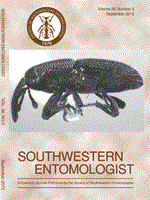An alternative to chemical barriers to protect structures from infestation by subterranean termites is the use of aggregate particles as a physical barrier to termite incursion into structures. Such physical barriers are less likely to threaten non-target organisms than are chemical termiticides applied to soil. Glass-tube bioassays of individual aggregate particle sizes retained on American Standard of Testing Materials (ASTM) sieve sizes 8, 10, and 12 were optimal for inhibiting subterranean termite incursion into structures. A factorial combination of numbers 8, 10, and 12 was generated to use all three sizes in physical barriers against subterranean termites. Engineering analysis of the aggregate particles (numbers 8, 10, and 12) indicated that angularity, fineness modulus, and weighted particle size were variables related to the success of physical particle barriers against subterranean termites. This study showed that all aggregate ratios of particle sizes 8, 10, and 12 were effective in inhibiting tunneling by subterranean termites. In the context of the critical aggregate particle sizes, angularity, weighted particle size, and fineness modulus, there was zero penetration by subterranean termites in 12 of the 19 ratios of numbers 8, 10, and 12.
How to translate text using browser tools
1 September 2013
Evaluation of Aggregate Particles as a Physical Barrier to Prevent Subterranean Termite Incursion Into Structures
T. Chris Keefer,
Dan G. Zollinger,
Roger E. Gold
ACCESS THE FULL ARTICLE

Southwestern Entomologist
Vol. 38 • No. 3
September 2013
Vol. 38 • No. 3
September 2013




